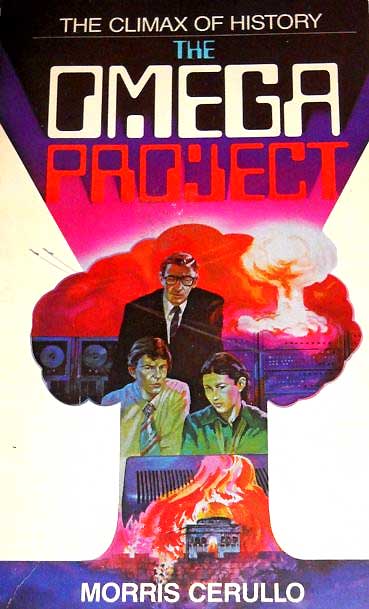 By MORRIS CERULLO (World Evangelism Inc.; 1981)
By MORRIS CERULLO (World Evangelism Inc.; 1981)
Evangelical rapture-themed fiction: encompassing titles like Salem Kirban’s 666 and the phenomenally popular LEFT BEHIND series, it’s a genre unto itself, having inspired a scholarly text (2009’s WRITING THE RAPTURE by Crawford Gribbin). THE OMEGA PROJECT, a slim paperback original, is not one of the genre’s better entries.
The author was the late Morris Cerullo (1931-2020), a Jewish born Pentecostal evangelist who in his day attracted both praise and controversy in equal measure. This is to say that Cerullo was beloved by his followers but investigated for tax evasion by the state of California, and permanently banned from at least one country (India, where a riot broke out at one of his rallies).
This book was supposedly adapted from a TV special entitled ADVENT 3, with extensive stills purporting to be from that program, yet I’ve been unable to find any record of this special ever having aired (much less existed). This leads me to believe that Cerullo may have been indulging in a scam that was quite common among smut publishers, who were known to cram their texts with non-existent movie stills.
Regarding the story, it is, even by traditional evangelical fiction standards, a bust. Lackluster and perfunctory, it’s set in the home of Israel’s prime minister. His dilemma: the mysterious disappearance of millions of people around the world. They’ve been raptured, of course, with those left behind forced to contend with various tribulations until God decides to finally put an end to it all. As the PM and his cohorts panic, a computer calls up relevant passages from the Book of Revelations, interspaced with passages describing Cerullo’s wanderings around Mount Megiddo in Israel, where the final battle is supposed to be fought. The book concludes, appropriately enough, not with that final battle but with Cerullo begging the reader to “have a share in this ministry,” i.e. to send him money.
The stills are just as you’d expect given the content. There are lots of depictions of people staring into computer screens and reading newspapers, as well as—surprise!—a full shot of Cerullo himself that opens the book. Also included is a fold-out “March of Prophecy” that proposes to chart, through a crudely drawn and rather confusing diagram, Biblical prophecy “from the beginning to eternity.”
